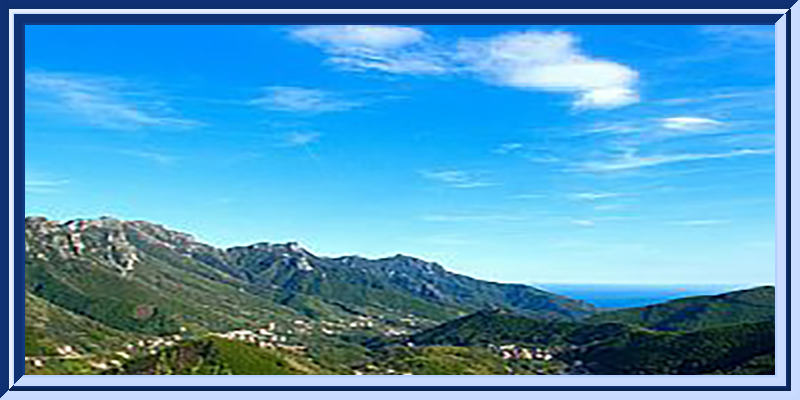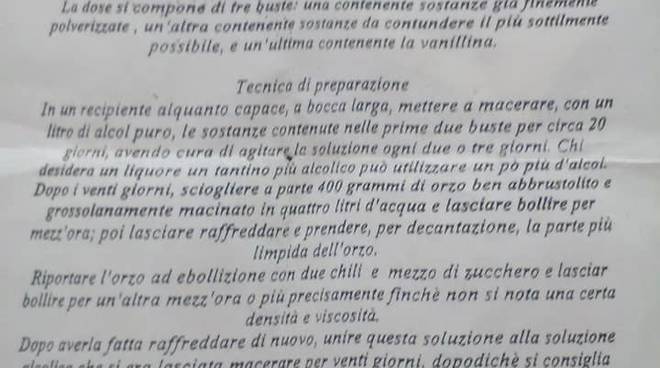

More than a town, Tramonti is a place composed of thirteen hamlets scattered
among the rugged hills above the Amalfi Coast. Tramonti is located along the Via Chiunzi, which leads to Maiori and the Amalfi Coast. Here you'll find vineyards,
chestnut woods, olive trees, grazing sheep and scented
lemon groves, set in a bucolic landscape, just eight kilometers from the sea.
 Tramonti
comes from "tra i monti", meaning "among the mountains". Tramonto (singular) in Italian means "sunset"
which is also apt for this collection of towns as they overlook the western sky. A
fascinating place founded by the Romans, like the closely-linked
neighboring town of Scala and Amalfi itself. According to historians, the
natives built the village of Cesarano between the IV
and the V century BC on the western side of Tramonti.
Cesarano has been the main center of Tramonti for a long time; the population gradually
increased and spread along the area that later on was
divided into different small villages.
Tramonti
comes from "tra i monti", meaning "among the mountains". Tramonto (singular) in Italian means "sunset"
which is also apt for this collection of towns as they overlook the western sky. A
fascinating place founded by the Romans, like the closely-linked
neighboring town of Scala and Amalfi itself. According to historians, the
natives built the village of Cesarano between the IV
and the V century BC on the western side of Tramonti.
Cesarano has been the main center of Tramonti for a long time; the population gradually
increased and spread along the area that later on was
divided into different small villages.
Even the coat of arms is allusive: three mountains surmounted by a crescent moon. Tramonti, as many other villages of the coast, cannot
be considered separately from Amalfi, as all the villages contributed to the
Republic's greatness through a long labor of skirmishes, invasions, and
victories, in which the various villages nearby had an important role. Tramonti was involved in the defense of Amalfi from the
incursions of the Lombard Arechi II and the ambitious
Sicard of Benevento, until Amalfi freed itself from the grasp of the Duke of
Naples (1 December 839) and reached a unique splendour
becoming a powerful maritime republic for several glorious centuries.
Tramonti took advantage of the commercial traffic in
Amalfi, augmenting trade and local artistic
production. The large number of churches, ancient monuments, and the presence
of dozens of noble families and illustrious men in these villages attests to
this role. With the fall of the Maritime Republic of Amalfi, caused by the
Normans, who dominated the coast for a while, Amalfi
and the villages around faced hard times and, as a consequence, Tramonti decreased its importance and
greatness. Today, Tramonti's villages give a
break from the crowded coast and a glimpse of rural life just a short distance
from the glittering resorts. Regional products and specialty foods are still
produced here and it's worth a trip uphill to see how they're made and buy
direct. The castle St Maria la Nova, was built along
with the castle Chiunzi in 1453 for want of Raimondo
Orsini, prince of Salerno and Duke of Amalfi.
The hamlets of Tramonti are:
- Pucara, where you can admire
the marvelous paintings by Luca Giordano in the church of St Maria
Maddalena and the Conservatory of St Giuseppe, which was founded in 1676
and famous as the birthplace of Concerto*, a popular liqueur.
- Novella, where the Amato-Venosi birth documents show our family
originated. 2022 Population: 78
- Paterno Sant'Elia
- Figlino
- Pietre
- Capitignano
- Paterno Sant'Arcangelo
- Corsano
- Campinola,
whose church of St John the Baptist exhibits an amazing altar-piece
representing the Virgin between St John the Baptist and St Francis, with
the donor Francesco Telese and angel musicians
(1608).
- Polvica,
administrative centre, housing a Franciscan
convent, built in 1474.
- Gete,
where you will be fascinated by the splendid rocky church of St Michele
Archangel.
- Ponte
- Cesarano
Some places of note:
- Monastery of St. Joseph and St.
Teresa, built in 1662
- Cappella Rupestre
(Chapel in the Rock), in the village of Gete. A
13th century church in a slight hollow of the rock, housing tombs cut into
the rocky side.
- Church of the Ascension
- Church of Sant'Elia
(Church of St. Elia), in the village of Sant'Elia
- Church of San Giovanni
(Church of St. John), in the village of Polvica
- Church of Pietro Apostolo (Church St. Peter Apostle), in the village of
Figlino C
- Church of Sant'Erasmo
- Castle of Montalto and
Hermitage of St. Catherine, at Paterno sant'Elia.
It was built by the Republic of Amalfi on a cliff of the Monti Lattari to protect its territories from the northern
side. It was stormed by the Normans in 1127 when the latter conquered the
Republic.
- Castle of Santa Maria La Nova.
It was built around 1457 by Raimondo Orsini, Prince of Salerno
and overlord of the Duchy of Amalfi. A rectangular base was fortified by
ten small square towers and seven ramparts, only some of which still
stands.
- Convent of Saint Francis,
founded in 1474.
* CONCERTO: THE LIQUEUR FROM TRAMONTI
The Italian name “Concerto”, translated into
English “Concert”, derives from the
harmony of the ingredients, a melody of tastes, while the recipe for preparing
it is strictly secret and has been handed down from generation to generation.
The “Concerto” is one of the oldest and most requested liqueurs of the Amalfi
Coast. It was prepared for the first time by the nuns of the Convent of Pucara,
a village belonging to the municipality of Tramonti.
The Italian name “Concerto”, translated into English “Concert”, derives from
the harmony of the ingredients: a melody of tastes. Its unique flavour comes from the combination of its ingredients:
herbs, spices, barley coffee and espresso.
The lemons utilized in the
preparation of this liqueur are those from Amalfi Coast or Sorrento, and even
today people from Amalfi, Capri, and Sorrento fight for the paternity of this
deliciousness. There are several hypotheses on its origin: some people think it
was utilized by fishermen or farmers to help them warm up during the cold
winter mornings; meanwhile, other people say that it was born in a monastic
convent. What is certain is that the entrepreneur Massimo Canale
from Capri was the first one to officially register the brand
"Limoncello" in 1998, proposing his grandmother’s recipe, whose name
was Maria Antonia Farace.
Today, the Limoncello is
the pride of this territory, full of excellent local ingredients that are used
in the preparation of delicious dishes. It is famous for its digestive
properties and sign of hospitality and tradition. Considering the long
preparation and the secret recipe, there is nothing better than being on the
Amalfi coast to taste it! After having lunch or dinner at one of the many
restaurants, ask for a little glass of Concerto, known for its digestive
properties. It is perfect to be served with ice-cream, coffee
and desserts, such as the famous Chocolate aubergines,
a traditional dessert for the feast of Assumption in Maiori
(whose chocolate sauce, for example, is usually flavoured
with the Concerto). Moreover, it is also used in the preparation of sauces for
meat and ragù (when you prepare the ragù, you can add the liqueur and simmer until the liquid
is reduced). On the Amalfi Coast you will have the opportunity to taste the
Concerto (the original one). It is not
just any liqueur, it is a sign of hospitality and
tradition which should be sipped and tasted slowly savouring
its unique flavour. All this and much more is waiting
for you on the Amalfi Coast, a treasure trove of wonders even for your palate.

An excerpt from a copy of the Concerto recipe from an old pharmacy
Acknowledgements to:
https://www.summerinitaly.com/guide/tramonti
https://travelamalficoast.travelmar.it/en/concerto-liqueur-from-amalfi-coast
https://holidaycoast.it/en/la-ricetta-del-liquore-delle-suore-il-concerto-di-tramonti